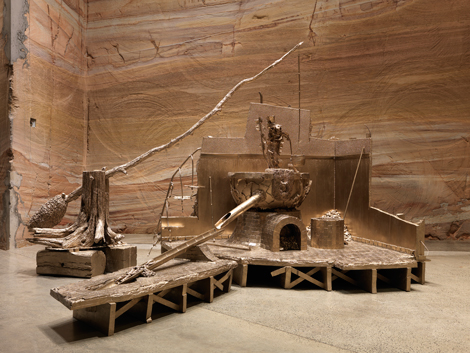Trying to communicate the plot of Matthew Barney’s recent, nearly six-hour opera, River of Fundament, makes me feel like the SNL character Stefon …“The movie has everything: Fran Lebowitz, gold-leafed poop, Egyptian gods, Elaine Stritch, classic cars, Maggie Gyllenhaal, a baby bird birthed from a woman’s vagina, Paul Giamatti, two pregnant women playing with an oversized feces dildo… ” The retelling is hilarious but it goes nowhere. This, it seems, is a signature Barney tactic: to throw as much as possible at his viewer in order to confuse critical focus. If the artist’s exhibition of the film and its attendant works at MOCA (its only U.S. venue) is any indication, this gimmick may be collapsing under its own weight.
A capsule synopsis betrays Fundament’s immensity, but it’s worth a try. The film is narratively indebted to Norman Mailer’s 1983 novel Ancient Evenings, a 700-plus-page confabulation of the ancient Egyptian Book of the Dead, set across multiple chronologies and planes of existence, where mortals and gods struggle for power in confrontations involving graphic sex and violence. With the aid of a hauntingly brackish score by Jonathan Bepler, Fundament takes this impenetrable narrative and layers in Mailer himself—or at least his spirit—as a key protagonist, searching for immortality through perpetual reincarnation in the form of symbolically loaded American cars, each tricked out in their own manner and destroyed in three grandiose Barneyesque “live performances,” staged by the artist in LA, Detroit and New York City. Add to this parallel plots with Egyptian gods, their human and animal forms, in overlapping spiritual and corporeal realms, each awash in metaphorical annotations and sumptuous, spectacle-driven imagery, and you have a film that succeeds in evading analysis through its humongousness.
Even so, while Fundament may drag along, it’s always a joy to watch. There’s something astonishing about seeing a rim job, or a decaying pig, projected four stories high, with the best, most expensively opulent technological bravado. However, the intoxication eventually gives way to sobering critique. Mailer’s pre-packaged grand failure is just one of many working schema Barney employs across his practice to avoid his work having to stand on its own in front of an audience that sincerely wants more than entertainment.
The same evasive pattern is evident in Barney’s enormous MOCA show. The first thing marking the exhibition is the bombastic language hailing the numerical triumphs in Barney’s work: the six-hour film took seven years to make; the show has 85 artworks; the work weighs 25 tons. These statistics may reflect the stupendous scale of the work, but they don’t justify its existence. Such conspicuous boasting comes across as desperate and most of the work can’t live up to the hype.

Matthew Barney, Boat of Ra (detail), 2014, wood, cast bronze, resin-bonded
sand, steel, and gold plating, 132 × 600 × 288 in., installation view of Matthew Barney: RIVER OF FUNDAMENT at Haus der Kunst, 2014, courtesy Laurenz Foundation, Schaulager, Basel, photo by Maximilian Geuter
The Mailer apartment showcased in Fundament is a fascinating feat, revealing itself to be a life-size, excised set piece set atop a barge moving along the Hudson River at the end of the film. Transporting the entire thing to MOCA, à la Universal Studios ride, would at least let us see Barney’s meticulous dedication to his spectacle, and maybe even perform one of art’s great missions: to challenge the boundaries between creative disciplines. But what we get at MOCA is a hollow and boring replica of the house’s skeletal roof. Turned upside down to reference a boat, holding a fractured cast of Mailer’s desk and a golden straightjacket from an entirely different part of the movie, the piece appears forced into looking like “art,” as if its original use was not important enough.
The problem with Barney’s insistence on extrapolating his set pieces, costumes, and stills from their film origins and transporting them, slightly tweaked or combined, to the gallery is that doing so does nothing to enrich the objects or the film, but only works as a gesture of tautological justification, as if to say, “You saw it there, and now it’s here, so it must be important.”

Matthew Barney, Shaduf, 2014, cast brass, 144 x 120 x 180 in., courtesy of the
artist and Gladstone Gallery, New York and Brussels, installation view of
Matthew Barney: RIVER OF FUNDAMENT at Museum of Old and New Art
(MONA), 2014-15, photo by Rémi Chauvin/MONA
The most fascinating objects in the MOCA show are vitrines holding Barney’s notes and source imagery for the film. Perusing these provides insight into the surprising influences that gave rise to Barney’s final shots. In one vitrine we see an image of Muhammed Ali swinging a punch next to a suite of pictures of car parts inserted into men’s anuses. Without having to relay the scenes where these images are employed, their connection to the final work is genuine and almost poetic. The vitrines walk a wonderful line between research and art, film and artifact, and do so without trying as hard as the other works in the show. If only the MOCA exhibition had consisted of the film’s continual screening and these vitrines, we might have been spared all the inconsequential ephemera masquerading as new sculpture.
However, to his credit, Barney’s latest water casting series made outside his film production holds imaginative promise. Made using a process that shoots molten metal inside a viscous clay, leaving the final form to organically harden in unpredictable spurts, these new works look both solid and liquid, heavy and weightless, impenetrable and delicate. The bronze-cast sculptures nod to Richard Serra’s heavy metal legacy, but seem even more unpredictable and precarious without being threatening. One work, cast in gold, is almost alive with light, growing and radiating right there in the museum.

Installation view of Matthew Barney WATER CASTINGS: Fourteen Pieces at Regen Projects, Los Angeles
September 11 – October 24, 2015
Photo: Joshua White. Courtesy Regen Projects, Los Angeles.
While the eight works from this series feel anomalous and even tacked-on alongside Barney’s movie at MOCA, they behave more autonomously, and exert a visceral reaction when exhibited independently at Regen Projects, the artist’s stalwart gallery in nearby Hollywood. The Regen space allows for a more intimate viewing, without the distractions of Barney’s unfortunate repurposed set pieces. And while Barney’s recent series of intricate etchings on cast-metal frames, also made apart from Fundament, are an afterthought at MOCA, their over-wrought sexualized imagery (a kind of Kiki Smith meets Dali fantasy) plays better at Regen Projects, if only because the restrained exhibition provides a clarity for cognitive and literal reflection. The lesson learned after visiting this final Barney exhibition is that the artist is best when he stops trying to complicate his ideas for the sake of contrived depth, and instead takes a real risk, letting the work have a life of its own.


